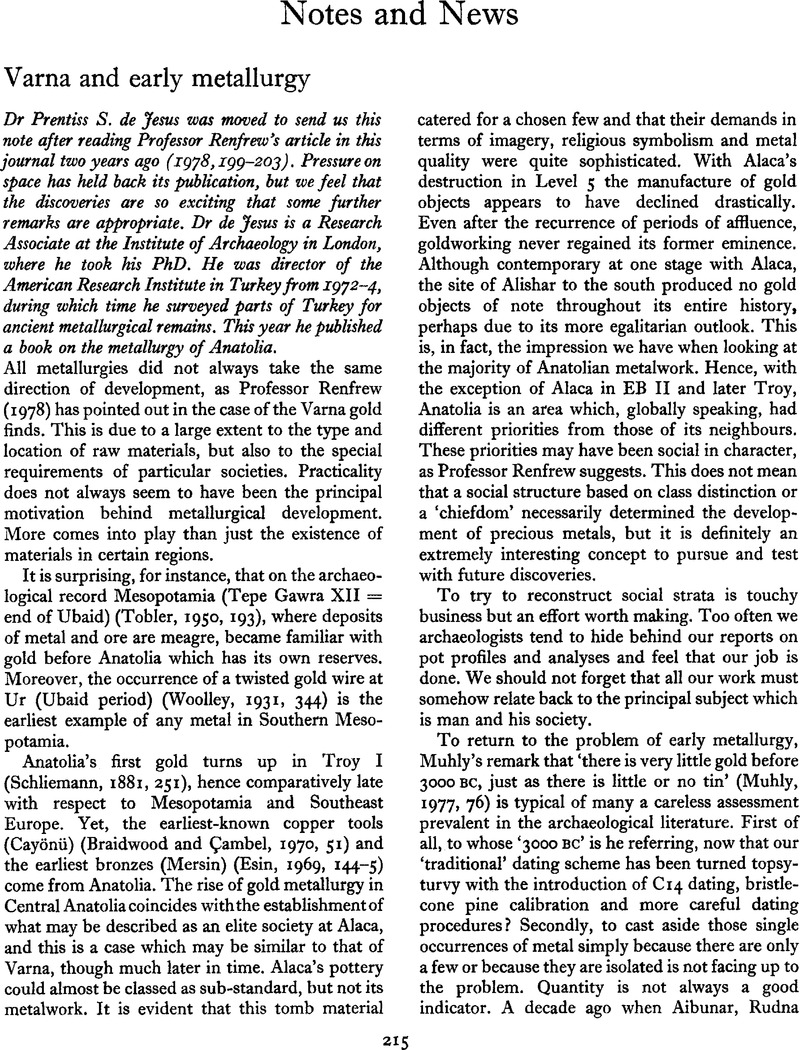No CrossRef data available.
Article contents
Notes and News
Published online by Cambridge University Press: 02 January 2015
Abstract
An abstract is not available for this content so a preview has been provided. As you have access to this content, a full PDF is available via the ‘Save PDF’ action button.

- Type
- Notes and News
- Information
- Copyright
- Copyright © Antiquity Publications Ltd 1980
References
BRAIDWOOD, R. & CAMBEL, H.
1970. An early farming village in Turkey, Scientific American,
222, 50–6.Google Scholar
ESIN, U.
1969. Kuantitatif spektral analiz yardimilya anadolu’da baslangicindan asur kolonileri çaĝitta kadar bakir ve tunç madenciliĝi (Istanbul).Google Scholar
MUHLY, J.
1977. The copper ox-hide ingots and the bronze age metals trade, Iraq,
XXXIX, 73–82.Google Scholar
RENFREW, C.
1978. Varna and the social context of early metallurgy, Antiquity,
LII, 199–203.Google Scholar
BARRETT, J.
1979. Later bronze age pottery in southern Britain, Current Archaeol., No. 67, 230–1.Google Scholar
CHAMPION, T.
1976. Britain in the European Iron Age
Archaeol. Atlantica,
1(2), 127–45.Google Scholar
CLARK, J.G.D. & FELL, C.I.
1953. The early iron age site at Micklemoor Hill, West Harling, Norfolk and its pottery, Proc. Prehist. Soc., XIX, 1–40.Google Scholar
COOMBS, D. & BRADSHAW, J.
1979. A carp’s tongue hoard from Stourworth, Kent, in (eds) BURGESS, C. & COOMBS, D.
Bronze age hoards, BAR 67, 181–196.Google Scholar
LONGLEY, D.
1976. Excavations on the site of a late bronze age settlement at Runnymeade Bridge, Egham, London Archaeol. 3 No. i, Fig. 4.9.Google Scholar
NORFOLK MUSEUMS SERVICE. 1977. Bronze age metalwork in Norwich Castle Museum (2nd ed).Google Scholar
LANTING, J.N.
1973. Laat-Neolithicum en vroege Bronstijd in Nederland en NW-Duitsland: Continue Ontwikkelingen, Palaeohistoria, XV, 216–317.Google Scholar
LANTING, J.N. & VAN DER WAALS, J.D.
1972. British Beakers as seen from the Continent, Helinium, XII.Google Scholar
PETCH, D.F.
1958. Archaeological notes for
1956, Lincoln Architectural and Archaeological Society Reports and Papers, No. 7.Google Scholar
WAINWRIGHT, G.J.
1979. Mount Pleasant, Dorset, excavations
1970–71, Society of Antiquaries Research Report No. XXXVN.CrossRefGoogle Scholar
WARREN, S.H.
et al. 1936. The archaeology of the submerged land surface of the Essex coast, Proc. Prehist. Soc., II, 178–210.Google Scholar
COLES, J.M.
HEAL, S.V.E. & ORME, B.J
1978. The use and character of wood in prehistoric Britain and Ireland, Proc. Prehist. Soc., XLIV, 1–45.Google Scholar
DAWSON, C.
1896. Note on the seals of the Barons and of the Bailiffs of Hastings, SAC,
XL, 261–5.Google Scholar
DAWSON, C.
1901. The services of the Barons of the Cinque Ports at the coronations of Kings and Queens of England ... SAC,
XLIV, 145–54.Google Scholar
DAWSON, C.
1902. Note on the Hastings Corporation relics of coronations of the Kings and Queens of England, SAC,
XLV, 110–13.Google Scholar
DAWSON, C. & LEWIS, J.
1896. Description of and remarks on the dungeon cells at Hastings Castle, SAC,
XL, 222–35.Google Scholar
SALZMAN, L.F.
1946. A history of the Sussex Archaeological Society, SAC,
LVIII, 65–90.Google Scholar
BRITTON, D.
1963. Traditions of metal-working in the Later Neolithic and Early Bronze Age of Britain: Part 1, Proc. Prehist. Soc.,
XXIX, 258–325.Google Scholar
CLOSE-BROOKS, J.
1975.
Notes on Museum acquisitions
1972–4, Proc. Soc. Antiq. Scot.,
CVI, 1974–5, 225–8.Google Scholar
COLES, J.
1969. Scottish early bronze age metalwork, Proc. Soc. Antiq. Scot.,
CI, 1968–9, 1–110.Google Scholar
EATON, E. & MCKERRELL, H.
1976. Near Eastern alloying and some textual evidence for the early use of arsenical copper, World Archaeol.,
VIII, 169–96.Google Scholar
KINNES, I.A., CRADDOCK, P.T
NEEDHAM, S. & LANG, J.
1979.
Tin-plating in the Early Bronze Age: the Barton Stacey axe, Antiquity,
LIII, 141–3.CrossRefGoogle Scholar
SMITH, J.A. & MACADAM, S.
1872. Notice of bronze celts or axe-heads, which have apparently been tinned; also of bronze weapons and armlets, found along with portions of metallic tin near Elgin in 1868, Proc. Soc. Antiq. Scot., ix, 428–43.Google Scholar
FINBERG, H.P.R..1964. Lucema: studies in some problems in the early history of England (Leicester).Google Scholar
GIBB, J.H.P.&GEM, R.D.H.
1975. The Anglo-Saxon cathedral at Sherborne, Arch. J.,
CXXXII, 105–10.Google Scholar
HUGHES, K.W.
1971. Evidence for contacts between the churches of the Irish and English from the Synod of Whitby to the Viking Age, in (eds) CLEMOES, P.A.M. & HUGHES, K.W.
England before the Conquest: studies in primary sources presented to Dorothy Whitelock (Cambridge).Google Scholar
LAPIDGE, M. & HERREN, M.
1979. Aldhelm: the prose works (Ipswich, Cambridge, New Jersey).Google Scholar
NORMAN, E.R. & ST JOSEPH, J.K.S.
1969. The early development of Irish society: the evidence of aerial photography (Cambridge).Google Scholar
ST JOSEPH, J.K.S.
1978. Aerial reconnaissance: recent results, 46, Antiquity,
LII, 236–7, PL. XXXII
Google Scholar
ALCOCK, L.
1963. Dinas Powys: an iron age, dark age and early medieval settlement in Glamorgan (Cardiff).Google Scholar
BOHME, H.W.
1974. Germanische Grabfunde des 4 bis 5 Jahrhunderts zwischen unterer Elbe und Loire (Munich).Google Scholar
ELLIS, S.E.
1969. The petrography and provenance of Anglo-Saxon and medieval English honestones with notes on some other hones, Bull. Brit. Mus. (Natur. Hist.).
Mineralogy, 2, 135–87.Google Scholar
HILLS, C.
1977. The Anglo-Saxon cemetery at Spong Hill, North Elmham. Part I.
East Anglian Archaeology Report No. 6.
Google Scholar
STEAD, I.M.
1958. An Anglian cemetery on the Mount, York, Yorkshire Archaeol. J.
XXXIX, 427–35.Google Scholar
THOMAS, S.
1960. Studien zu den Germanischen Kammen der Romischen Kaiserzeit, Arbeits-und Forschungs- berichte zur Sachsischen Bodendenkmalpflege Band 8, 54–215.Google Scholar


